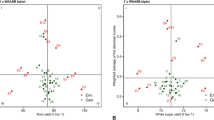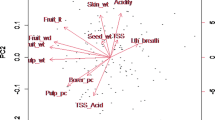Summary
Selection against pith and tube is one of the major criteria used to eliminate inferior sugarcane (Saccharum spp.) cultivars in early stages of new cultivar evaluation. Understanding the genetic relationships for these traits would facilitate crossing and selection decisions. This study was conducted to determine heritability, genetic coefficient of variation, and the potential for genetic advance by selection for pith, tube, and stalk density. Correlation and path-coefficient analysis studies were conducted to determine the effects of Brix, pith, and stalk density on sucrose content and the effects of stalk volume, tube, and pith on stalk weight. Eighty randomly selected cultivars (four progeny from each of 20 crosses), representing a first clonal stage of a Louisiana sugarcane breeding population, and their parents were planted at St. Gabriel/LA, and yield data were collected in 1986, 1987, and 1988. Pith and tube exhibited large genotype and genotype-by-year variation, whereas variation in stalk density was nonsignificant. Broad-sense and narrow-sense heritabilities were high, moderately high, and low for pith, tube, and stalk density, respectively. Path-coefficient analysis revealed that stalk volume was the major factor determining stalk weight. Tube and pith were factors that decreased stalk weight. As expected, Brix was the single most important factor determining sucrose content, however, high stalk density and low pith were also associated with high sucrose content. Sugarcane breeders should practice stringent selection for low pith across years to increase stalk weight and sucrose content. Since stalk density was effectively increased by high sucrose content and low pith, the use of stalk density in breeding and selection should be avoided. The minimal effect of tube on stalk weight suggests that its use as selection criteria be minimized or dropped.
Similar content being viewed by others
References
Allard RW (1960) Principles of plant breeding. Wiley, New York
Becker WA (1984) Manual of quantitative genetics, 4th edn. Academic Enterprises, Pullman/WA
Breaux RD (1972) Selecting commercial sugarcane varieties from large seedling and clonal populations. Proc Am Soc Sugarcane Technol 2(ns):58–66
Breaux RD, Matherne RJ, Millhollon RW, Jackson RD (1972) Culture of sugarcane for sugar production in the Mississippi delta. USDA Agric Handbook No. 417
Dewey DR, Lu KH (1959) A correlation and path-coefficient analysis of components of crested wheatgrass seed production. Agron J 51:515–518
Dickerson GE (1969) Techniques in research in quantitative animal genetics. In: Techniques and procedures in animal production research. American Society of Animal Science, Champaign/IL
Dillewijn CV (1952) Botany of sugarcane. Chronica Botanica, New York
Dudley JW, Moll RH (1969) Interpretation and use of estimates of heritability and genetic variances in plant breeding. Crop Sci 9:257–262
Dutt NL, Rao JT (1950) Progeny tests and inheritance of pith in sugarcane seedlings. Proc 1st Biennial Conf Sugar Res, India, Part I
Evans H (1966) The incidence of pithiness in sugarcane and its effect on yield and quality. Proc Br West Indies Sugar Technol 1:119–132
Falconer DS (1981) An introduction to quantitative genetics. 2nd edn. Longman Press, London
Hallauer AR, Miranda JB (1981) Quantitative genetics in maize breeding. Iowa State University Press, Ames/IA
Imran M (1986) Heritability of flowering. PhD dissertation Louisiana State University, Baton Rouge/LA
Kang MS, Miller JD, Tai PYP (1983) Genetic and phenotypic path analyses and heritability in sugarcane. Crop Sci 23: 643–647
Lakshmikantham M (1946) Pith in sugarcane. Curr Sci 15: 284–285
Legendre BL, Henderson MT (1972) The history and development of sugar yield calculations. Proc Am Soc Sugarcane Technol 2(ns):10–18
Verma G (1948) Studies in pithiness in sugarcane. Chronica Botanica, Waltham/MA
Author information
Authors and Affiliations
Additional information
Communicated by A. R. Hallauer
Approved for publication by the director of the Louisiana Agricultural Experiment Station as Manuscript No. 89-09-3203
Rights and permissions
About this article
Cite this article
Gravois, K.A., Milligan, S.B. & Martin, F.A. The role of pith, tube, and stalk density in determining sugarcane sucrose content and stalk weight. Theoret. Appl. Genetics 79, 273–277 (1990). https://doi.org/10.1007/BF00225963
Received:
Accepted:
Issue Date:
DOI: https://doi.org/10.1007/BF00225963




